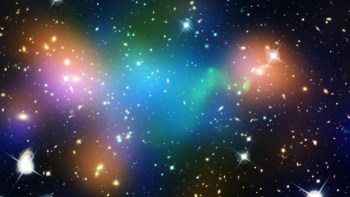Two teams of astrophysicists have detected features in the large-scale distribution of galaxies that can be traced back to fluctuations in the cosmic microwave background. The variations in the cosmic background are thought to result from quantum fluctuations in the very early universe, shortly after the big bang. The results, which were presented at the American Astronomical Society (AAS) meeting in San Diego yesterday, provide further evidence for the standard big bang plus inflation model of cosmology.
The cosmic microwave background (CMB) has a perfect black-body spectrum with a temperature of 2.73 Kelvin. However, this temperature varies very slightly at different points in the sky, corresponding to the slight variations in the distribution of matter that existed some 380 000 years after the big bang.
When the power spectrum of the CMB is plotted as a function of angle it contains a series of peaks that can be explained in terms of sound waves travelling back and forth across the early universe. Two teams of astrophysicists — the Sloan Digital Sky Survey (SDSS) and the 2dF Galaxy Redshift Survey (2dFGRS) — have now shown that these fluctuations in the CMB grew under the influence of gravity to produce the pattern of galaxies and clusters of galaxy that we see today. Both teams have detected a feature known as the “baryon acoustic peak”.
The SDSS team, which uses the 2.5 m Sloan telescope in New Mexico, mapped more than 46 000 galaxies over a volume of space around five million light years in diameter. The SDSS team says that the results agree perfectly with the standard model of cosmology in which 5% of the universe is made of ordinary baryonic matter, with 25% dark matter and 70% dark energy. However, the nature of dark matter and dark energy remains a mystery.
The 2dFGRS team have come to the same conclusion based on a smaller survey with the 3.8 m Anglo-Australian telescope. “It is impressive verification of the standard cosmological model that two groups with independent data have both made significant detections of the baryon-induced features in large-scale galaxy clustering,” says Shaun Cole of Durham University in the UK, who is the first author of the 2dFGRS paper (submitted to the Monthly Notices of the Royal Astronomical Society).
“These baryon features are the genetic fingerprint of our universe,” says Carlos Frenk, also of Durham. “They establish a direct evolutionary link to the big bang. Finding them is a milestone in our understanding of how the cosmos was formed.”
The SDSS team has submitted its results to the Astrophysical Journal.



